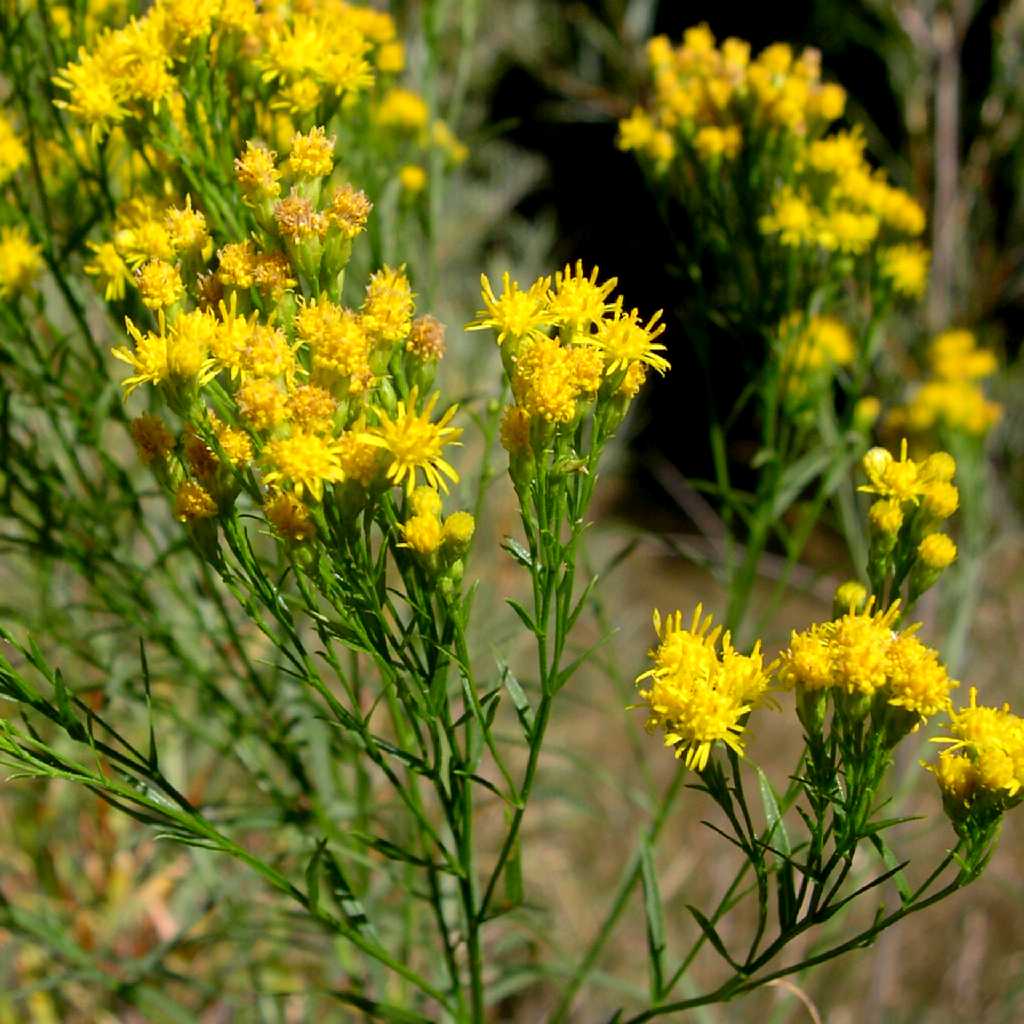Euthamia
|
Family: Asteraceae |
Perennials or subshrubs, 40-200 cm (rhizomes creeping, fibrous-rooted). Stems erect (nearly terete), simple or branched, glabrous or hairy. Leaves cauline; alternate; sessile; blades (± uniform along stems) linear to lanceolate (40-130 mm), margins entire, faces glabrous or hairy, sparsely to densely gland-dotted (dots obscure or evident, 0.1-0.25 mm diam., 0-86 per mm²). Heads radiate, borne singly or (glomerulate) in corymbiform or paniculiform arrays. Involucres obconic to hemispheric, (2.5-6.3 ×) 2.1-8.1 mm. Phyllaries 11-29 in 3-5 series, 1-nerved (flat), linear to ovate, bases often stramineous or pale, margins chartaceous or weakly cartilaginous, not scarious (apices with green zones, erose to ciliate), abaxial faces glabrous, little to very resinous. Receptacles flat, pitted (pit borders ± fimbrillate), epaleate. Ray florets 7-22(-35) (usually more numerous than disc florets), pistillate, fertile; corollas yellow. Disc florets 3-22, bisexual, fertile; corollas yellow, tubes shorter than tubular to slender-funnelform throats, lobes 5, erect to ascending, oblong-lanceolate; style-branch appendages lanceolate. Cypselae oblong to narrowly ellipsoid, ± terete, 2-4-nerved, strigose; pappi persistent, of 20-30, white, ± equal, antrorsely barbellate, apically attenuate bristles in 1 series. x = 9. Euthamia was formerly included in Solidago. Arrangements of heads, gland-dotted leaves, and DNA sequence data demonstrate that Euthamia should be treated as distinct from Solidago (L. C. Anderson and J. B. Creech 1975; R. D. Noyes and L. H. Rieseberg 1999). Ambiguous and contradictory information has led to much debate about who named Euthamia (D. J. Sieren 1981; K. N. Gandhi 1999; G. L. Nesom 1999; J. L. Strother 2000). I consider correct authorship for this genus to be as given in Index Nominum Genericorum (http://ravenel.si.edu/botany/ing). Euthamia is capable of tremendous phenotypic variation. Transitional aspects of a given plant are much more likely to be related to environmental factors than to introgression. Heights of arrays are determined by measuring from the summit of the plant to the bases of proximalmost head-bearing branches.
Heads radiate, the rays 7-30(-35), small, pistillate and fertile; invol ±glutinous, its small, chartaceous, yellowish or green-tipped bracts imbricate in several series; receptacle small, usually ±fimbrillate; disk-fls perfect and fertile, 2-12(-20), in most spp. fewer than the rays; style-branches flattened, with lanceolate, externally short-hairy appendage; achenes several-nerved, short-hairy; pappus of numerous white capillary bristles; rhizomatous perennial herbs with numerous, alternate, resinous-punctate, narrow, entire, sessile or subsessile, mainly or wholly cauline lvs and ±numerous small yellow heads pedunculate or often sessile in small glomerules, commonly forming a terminal, corymbiform, flat-topped infl. 8, N. Amer. All spp. bloom in mid- or late summer and fall. (Often included in Solidago) Gleason, Henry A. & Cronquist, Arthur J. 1991. Manual of vascular plants of northeastern United States and adjacent Canada. lxxv + 910 pp. ©The New York Botanical Garden. All rights reserved. Used by permission. |

